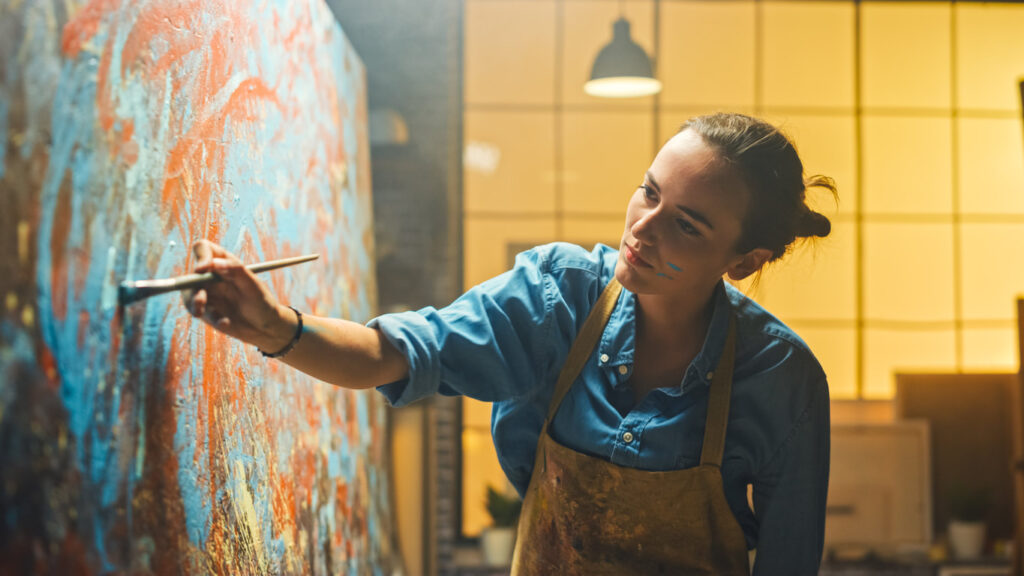The 2025 Guide on How to Make Money as an Artist
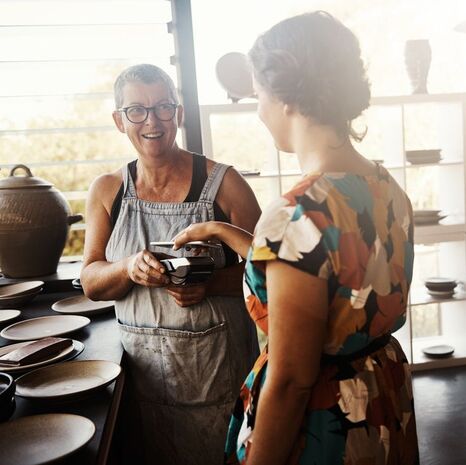
If you want to know how you can start making money as an artist, regardless of your creative medium or experience level, then you’re in the right place. I’m going to walk you through some proven strategies that will immediately help you start making money as an artist.
Whether you’re a visual artist like a painter, sculptor, wood, metal or fiber artist, potter, jeweler or anything else, you’ll learn strategies that work for you here. And don’t worry if you’re a writer or content creator. I will be sharing some great information that will work equally for you, so let’s get started.



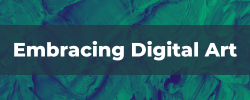

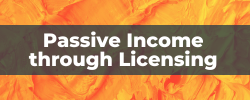

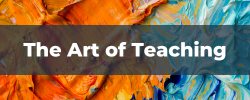




An Overview on How to Make Money with Art

Welcome to our comprehensive guide on how to make money with art. Whether you’re an established artist looking to expand your income streams or an aspiring creative seeking to monetize your passion, this resource will provide you with valuable insights and practical strategies to turn your artistic skills into a lucrative venture.
Art has the power to inspire, captivate, and evoke emotions in people across the globe – especially when empowered by the Holy Spirit. It is not only a form of self-expression but also a potential avenue for financial success. In today’s digital age, opportunities for artists to earn money from their craft have expanded significantly, offering a multitude of possibilities beyond traditional gallery sales.
In this guide, we will explore various avenues through which artists can generate income. We’ll delve into both time-tested methods and emerging trends, equipping you with the knowledge and tools necessary to thrive in the modern art market based on The Artist Cashflow Wheel™ – a powerful, proven framework for not only selling art, but creating consistent cashflow in your art business so you can make art, make a living and make a difference.
Next, we’ll explore the traditional path of selling art and answer the common topic of how to make money as a traditional artist. We’ll discuss the process of approaching galleries, participating in art fairs, and establishing an online presence through dedicated art marketplaces or personal websites. You’ll gain valuable insights on pricing your artwork, effectively marketing yourself, and navigating the logistics of shipping and handling. We’ll also discuss why developing strategic partnerships in your art business is a powerful strategy for developing a steady flow of ongoing business.
But that’s just the beginning. We’ll also explore the realm of digital art, which has witnessed tremendous growth in recent years. From creating digital illustrations and animations to exploring the realm of virtual reality and augmented reality experiences, we’ll help you understand the potential of this exciting and rapidly evolving field.
Additionally, we’ll discuss the concept of licensing your artwork. By granting others the right to use your art on various products such as clothing, home decor, or even in advertising campaigns, you can unlock a passive income stream. We’ll delve into the world of licensing, providing you with tips on how to approach potential partners, negotiate contracts, and protect your intellectual property rights.
Crowdfunding has become a game-changer for many artists, enabling them to finance their projects and connect directly with their supporters. We’ll guide you through popular crowdfunding platforms like Kickstarter and Patreon, helping you craft compelling campaigns, set achievable goals, and reward your backers in meaningful ways.
Teaching art can also be a rewarding avenue for artists to share their knowledge and generate income. We’ll explore different teaching models, from conducting in-person workshops and classes to leveraging online platforms and creating educational content. You’ll discover how to develop engaging curriculum, effectively market your teaching services, and build a loyal student base.
Furthermore, we’ll discuss the potential of freelance work for artists. Whether it’s graphic design, illustration, or photography, we’ll provide insights into freelancing in the creative industry. You’ll learn how to market your skills, find clients, and navigate the freelance landscape to secure projects that align with your artistic vision.
We’ll also discuss the power of selling your art through social media platforms like Facebook, Instagram, Tiktok, Youtube and others. You’ll not only learn what’s possible but you’ll also discover how to leverage these platforms for yourself now to start making money as an artist.
Finally, we’ll explore the exciting world of digital currencies and non-fungible tokens (NFTs). These blockchain-based technologies have revolutionized the art market, offering new opportunities for artists to monetize their digital creations. We’ll provide a comprehensive overview of NFTs, explain how to mint and sell them, and discuss the potential benefits and challenges associated with this emerging trend.
Throughout this guide, we’ll also emphasize the importance of building a strong personal brand, cultivating a supportive network, and continuously honing your artistic skills. Making money with art requires not only talent but also business acumen, adaptability, and perseverance.
Whether you’re a painter, sculptor, photographer, digital artist, or any other creative soul, this guide is designed to empower you with the knowledge and inspiration to thrive in the world of art and commerce. So, let’s embark on this journey together and unlock the endless possibilities of monetizing your artistic endeavors. Get ready to transform your passion into a sustainable and fulfilling career.
Two Kinds of Income Generation in Art: Recurring & Non-Recurring

Every artist who wants to build a strong, healthy business with consistent cashflow needs two kinds of income generation in art: recurring and non-recurring. Recurring income refers to income that an artist receives on a regular basis, such as monthly or annually, while non-recurring income is income that is earned only once or irregularly. Within these two simple categories are massive amounts of ideas for creating streams of income for artists.
Recurring Income
Lots of artists nowadays are wanting to know how to make passive income as an artist. While no income for artists is truly passive (your business
always requires work and attention), recurring income can provide continuity and stability while giving you the freedom to do other things in your art business. For artists, recurring income streams can include things like:
- Royalties: Artists can earn royalties from the sale of their art, such as prints, merchandise, or books. These royalties can be recurring, as long as the product continues to sell.
- Subscription services: Artists can offer their fans the option to pay a recurring fee for access to exclusive content, such as behind-the-scenes updates, early access to new work, or personalized artwork. It can also include a monthly membership for students, fans or clients.
- Teaching or coaching services: As mentioned earlier, artists can teach classes or offer coaching services to students or aspiring artists on a regular basis, earning recurring income.
Non-Recurring Income
Non-recurring income streams for artists can include things like:
- Commissions: Artists can earn income by creating commissioned artwork for clients. However, these commissions may not be recurring and can depend on the availability of clients.
- One-time sales: Artists can earn income from one-time sales of their artwork, such as selling a painting or sculpture at an exhibition or online marketplace. This could also include one-time sale of online courses, etc.
- Grants or awards: Artists can apply for grants or awards, which provide one-time funding for a specific project or exhibition.
It’s important for artists to diversify their income streams to ensure a stable and sustainable income. Both recurring and non-recurring income streams can be beneficial for an artist’s financial success.
The Artist Cashflow Wheel: Unlocking Financial Success & Fulfillment for Artists
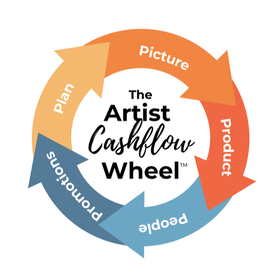
For many artists, the lack of consistent income can hinder their ability to fully focus on their art and live out their creative calling. The Artist Cashflow Wheel™ offers a powerful methodology to build a healthy, profitable, and fulfilling art business with consistent income.
By aligning with God’s plan and implementing the five essential components of the The Artist Cashflow Wheel™, artists can overcome financial challenges, experience abundance, and fully step into their creative destiny.
- Overcoming Financial Frustration
Without a faithful income stream, artists often find themselves pursuing unrelated income opportunities, feeling drained and overwhelmed, and struggling to make ends meet. The Artist Cashflow Wheel™ addresses these challenges by providing a clear path to financial stability, allowing artists to dedicate their time, energy, and focus to their art and God’s calling. - Aligning with God’s Best
By embracing The Artist Cashflow Wheel™, artists can align with God’s best for their lives. Through a faithful income stream, artists can receive God’s abundant provision in line with their unique design and assignment. This alignment empowers artists to prioritize their art, their family, and their creative calling, bringing fulfillment and purpose to their lives. - The Five Components of the Artist Cashflow Wheel
a. Picture: This component involves understanding the vision for your art business and discerning God’s plan for your life. By gaining clarity on your purpose and artistic direction, you can align your efforts with your divine calling.
b. People: Building authentic relationships with your ideal clients and strategic partners is vital for sales and referrals. By identifying and engaging with the right audience, you can establish a strong support network and create meaningful connections that lead to financial success.
c. Product: Focusing artistically and selecting the right products within your area of expertise and passion is crucial for maximizing sales potential. By understanding market demand and refining your offerings, you can create products that resonate with your target audience.
d. Promotions: Developing a comprehensive marketing strategy is essential for generating consistent income. Utilizing the PROPEL Artist Marketing Framework™, you can create effective promotional campaigns, leverage various marketing channels, and reach a broader audience.
e. Plan: Creating a 12-month plan ensures a steady flow of income throughout the year. By strategically mapping out your goals, projects, and revenue streams, you can minimize financial gaps and ensure a consistent cashflow for your art business.
The Artist Cashflow Wheel™ offers a transformative approach for artists seeking financial stability, fulfillment, and the ability to fully embrace their creative calling. By implementing the five components of the Cashflow Wheel – Picture, People, Product, Promotions, and Plan – artists can unlock a path to consistent income, align with God’s best for their lives, and experience the joy of creating art without financial constraints. Embrace the Artist Cashflow Wheel™ and step into a future where your art thrives, your financial needs are met, and you fulfill your unique purpose as an artist in God’s Kingdom.
Want to learn more about how to implement The Artist Cashflow Wheel™ into your art business?
The Traditional Pathway for Selling Art
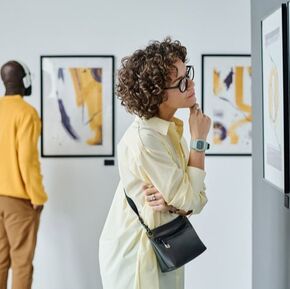
The traditional path of selling art has long been a cornerstone for artists seeking to showcase their work and generate income. While the art market has evolved with the advent of technology, the avenues of approaching galleries, participating in art fairs, and establishing an online presence remain vital strategies for artists. In this article, we will explore these traditional avenues, providing valuable insights on pricing artwork, effective self-marketing, and navigating the logistics of shipping and handling.
- Approaching Galleries
Galleries serve as gatekeepers to the art world, offering artists the opportunity to exhibit and sell their work to a discerning audience. Approaching galleries requires a well-prepared portfolio, professional presentation, and a thoughtful understanding of the gallery’s style and target market. Research and identify galleries that align with your artistic style and vision. Submit a concise and compelling portfolio with high-quality images, an artist statement, and a professional resume. Building relationships with gallery owners and attending exhibition openings can also help establish a presence within the art community.
- Participating in Art Fairs
Art fairs provide a dynamic platform for artists to showcase their work to a broader audience of collectors, art enthusiasts, and gallery representatives. Research and select art fairs that cater to your artistic style, target audience, and budget. Prepare a visually striking booth or display that highlights your artwork effectively. Engage with visitors, share your artistic process, and be ready to discuss your work. Consider offering limited-edition prints or smaller works to cater to varying budgets. Networking with fellow artists, collectors, and gallery owners can open doors to future opportunities.
- How can artists sell their work at an art fair? Art fairs provide a bustling selling environment that can be a great starting point for new artists looking to showcase and sell their work. One of the key advantages of art fairs is the opportunity for face-to-face interactions with potential customers, which is something that online platforms often lack. By being physically present at your stall, you can engage shoppers directly and build relationships with potential buyers. It gives an artist instant feedback on their work and invaluable practice speaking to prospects about their process, product and artistic story. Moreover, art fairs also offer ample networking opportunities where you can connect with fellow artists and professionals in the art industry, which can be highly beneficial for your artistic career.
However, participating in an art fair requires some careful planning and research. Since you will have a physical store, it is important to consider all the necessary materials and objects you will need for your display. Additionally, it’s crucial to factor in the various costs associated with art fairs, such as fees for booth spaces, transportation, and art materials. (I’ve always carried a “show box” with me complete with all the tools and tech I need for a show. It’s useful and gives me a ton of peace of mind.) Therefore, choosing the right art fair becomes even more crucial to ensure that you make the most of your investment.
Regardless of the number of sales you make during an art fair, it is a valuable experience as an artist. Even if people don’t make immediate purchases, they will have the opportunity to physically see your art and potentially take away your business card. This can lead to future sales or commissions as they might reach out to you later. Ultimately, participating in art fairs allows you to showcase your work, engage with potential buyers, and establish a physical presence within the art community.
- How can artists sell their work at an art fair? Art fairs provide a bustling selling environment that can be a great starting point for new artists looking to showcase and sell their work. One of the key advantages of art fairs is the opportunity for face-to-face interactions with potential customers, which is something that online platforms often lack. By being physically present at your stall, you can engage shoppers directly and build relationships with potential buyers. It gives an artist instant feedback on their work and invaluable practice speaking to prospects about their process, product and artistic story. Moreover, art fairs also offer ample networking opportunities where you can connect with fellow artists and professionals in the art industry, which can be highly beneficial for your artistic career.
- Establishing an Online Presence
In today’s digital age, establishing an online presence is essential for artists to reach a global audience and expand their sales potential. Creating a dedicated website or utilizing art marketplaces provides an opportunity to showcase your portfolio, share your artistic journey, and facilitate direct sales. When building a website, ensure it reflects your artistic style, is easy to navigate, and includes high-quality images of your artwork. Utilize search engine optimization techniques to increase visibility and drive traffic to your site. - Art Marketplaces
Modern art marketplaces such as Saatchi Art, Artful Home, Fine Art American, Artsy, or Etsy, offer exposure to a larger customer base and handle aspects like payment processing and shipping logistics. Research various online platforms to find those that align with your artistic goals and target audience. Engage with potential buyers, respond promptly to inquiries, and consistently update your portfolio with new work. Utilize social media platforms to drive traffic to your website or online marketplace, sharing behind-the-scenes insights and engaging with followers.
- What are some challenges of selling on Etsy and other platforms? Selling on Etsy and other online art sales platforms poses several challenges that aspiring sellers should consider. One challenge is the time it takes to generate enough sales to sustain oneself financially. It may require a considerable amount of time and effort to build and establish a successful shop on Etsy, etc. Therefore, don’t just rely on these platforms alone to bring you traffic. Send traffic from your own website to your your stores on Etsy, Artful Home and the like. As you grow your online store, it is important to be prepared to have alternative sources of income.
Another challenge is the need to manage expectations regarding the financial support Etsy and other platforms can offer. Many experienced sellers on many online platforms highlight that they often maintain another job alongside their online shop. Relying solely on Etsy and other sales platforms for immediate financial stability may not be realistic, and it is crucial to carefully plan and strategize for sustainable income. Like building any business, especially an art business, it takes time and consistency.
These challenges underscore the importance of being aware of the potential limitations of selling on Etsy and others. While the platform offers numerous advantages, sellers should approach it with a clear understanding of the time and effort required for success. By being prepared and having realistic expectations, sellers can navigate these challenges effectively and build a thriving online art business.
- What are some challenges of selling on Etsy and other platforms? Selling on Etsy and other online art sales platforms poses several challenges that aspiring sellers should consider. One challenge is the time it takes to generate enough sales to sustain oneself financially. It may require a considerable amount of time and effort to build and establish a successful shop on Etsy, etc. Therefore, don’t just rely on these platforms alone to bring you traffic. Send traffic from your own website to your your stores on Etsy, Artful Home and the like. As you grow your online store, it is important to be prepared to have alternative sources of income.
- Pricing Your Artwork
Determining the right price for your artwork is a delicate balance that considers factors such as your artistic reputation, size, medium, complexity, and the market demand for your work. Research similar artworks by artists at a similar stage in their careers to gain insights into pricing trends. Take into account the cost of materials, your time, and any additional expenses incurred during the creative process. Gradually increase your prices as your reputation and demand grow, but remain mindful of market fluctuations and feedback from buyers and galleries. For more on pricing your artwork, visit this page all about it. - Effective Marketing and Self-Promotion
To succeed in selling art, effective marketing and self-promotion are crucial. Craft a compelling artist statement that communicates your artistic vision and resonates with your target audience. Develop a consistent brand identity across your online presence and promotional materials. Engage with the art community by attending openings, networking events, and workshops. Collaborate with other artists or organizations to gain exposure and cross-promote. Leverage the power of social media to share your work, engage with followers, and build a loyal fan base. - Navigating Shipping and Handling Logistics
Once you make a sale, it is important to navigate the logistics of shipping and handling with care. Ensure your artwork is properly packaged to avoid damage during transit. Use archival-quality materials and consider insurance for high-value pieces. Research reputable shipping carriers or work with specialized art shipping companies to ensure the safe and timely delivery of your artwork. Provide clear instructions to buyers regarding unpacking and handling the artwork, as well as any care instructions or certificates of authenticity.
The traditional path of selling art through galleries, art fairs, and online marketplaces remains a valuable avenue for artists to showcase their work and generate income. By approaching galleries with a professional portfolio, participating in art fairs, establishing an online presence, pricing artwork thoughtfully, effectively marketing themselves, and navigating shipping and handling logistics, artists can navigate this path with confidence. Embrace these traditional strategies while adapting to emerging trends, and your artistic career will have a strong foundation for success.
The Power of Strategic Partners in Building a Thriving Art Business

In the art world, building a successful business goes beyond creating captivating artwork. It involves cultivating relationships and strategic partnerships that can propel your art career forward. Developing connections with trusted business people, industry leaders, fellow artists, and others can open doors to opportunities, expand your reach, and create a steady flow of ongoing business. In this article, we will explore the reasons why strategic partnerships are a powerful and profitable strategy for artists looking to build a thriving art business.
- Amplifying Your Reach
By forming strategic partnerships, you can tap into the existing networks and audiences of your partners, expanding your reach far beyond your immediate circle. Collaborating with industry leaders, galleries, or influencers allows you to showcase your artwork to new audiences who may be interested in purchasing or promoting your work. This increased visibility can lead to a broader client base and increased sales opportunities. - Accessing Expertise and Resources
Strategic partnerships provide access to expertise, resources, and knowledge that can help you grow your art business. Collaborating with trusted business people who specialize in marketing, branding, or sales can provide valuable insights and guidance. Industry leaders can offer mentorship, share their experiences, and provide opportunities for professional growth. Leveraging the resources and connections of your partners can help you navigate challenges more effectively and accelerate your artistic journey. - Collaboration and Inspiration
Partnering with fellow artists creates a collaborative and inspiring environment that fosters creativity and innovation. Collaborative projects, joint exhibitions, or group shows allow artists to combine their unique styles, skills, and perspectives to create something truly exceptional. This collaborative spirit not only enhances the quality of your work but also opens doors to new opportunities and potential collaborations in the future. - Joint Marketing and Promotional Efforts
Strategic partnerships enable artists to pool their resources and efforts in marketing and promotion, leading to a more impactful and cost-effective approach. By cross-promoting each other’s work, sharing audiences, and participating in joint marketing campaigns, you can reach a wider audience and generate more interest in your art. This collaborative marketing approach not only saves time and resources but also creates a sense of community and support among artists. - Diversifying Revenue Streams
Strategic partnerships can help artists diversify their revenue streams by exploring new avenues and markets. Partnering with businesses in complementary industries, such as interior design firms or creative agencies, can lead to opportunities for commissioned artwork, collaborations on commercial projects, or licensing agreements. These partnerships can provide consistent income and long-term business relationships. - Nurturing Long-Term Relationships
Building strategic partnerships is not just about short-term gains; it’s about fostering long-term relationships. By investing time and effort into developing genuine connections with your partners, you can create a network of trusted allies who will support and advocate for your art business. These relationships can lead to recurring collaborations, referrals, and a strong support system throughout your artistic journey.
Strategic partnerships are a powerful and profitable strategy for artists looking to build a thriving art business. By amplifying your reach, accessing expertise and resources, fostering collaboration and inspiration, leveraging joint marketing efforts, diversifying revenue streams, and nurturing long-term relationships, you can unlock new opportunities and establish a steady flow of ongoing business. Embrace the power of strategic partnerships, surround yourself with trusted allies, and watch your art business flourish as you navigate the art world with confidence and success.
What Strategic Partners are Potentially Best for Artists Growing an Art Business?
When seeking strategic partners to help sell their work, artists should consider individuals and organizations that align with their artistic vision and target audience. Here are some potential strategic partners for artists:
- Art Galleries and Curators
Collaborating with reputable art galleries and curators can provide exposure to a wider audience and enhance your credibility as an artist. These partnerships can lead to solo or group exhibitions, representation, and networking opportunities within the art industry. - Interior Designers and Decorators
Partnering with interior designers and decorators allows artists to showcase their work in residential or commercial spaces. Collaborating on projects such as art installations, commissions, or providing artwork for staging can lead to sales and exposure to potential clients. - Online Art Marketplaces
Joining established online art marketplaces like Saatchi Art, Artsy, or Etsy can provide access to a large customer base actively seeking art. These platforms offer exposure, marketing tools, and e-commerce capabilities, making it easier for artists to sell their work online. - Art Consultants and Advisors
Collaborating with art consultants or advisors who specialize in helping clients acquire artwork can be mutually beneficial. These professionals work closely with collectors, corporations, and individuals looking to invest in art. By building relationships with them, artists can increase their chances of selling their work to interested buyers. - Local Businesses and Cafes
Partnering with local businesses, cafes, or restaurants can offer exposure to a targeted local audience. Displaying your artwork in these establishments or organizing art events can lead to sales and attract potential buyers who appreciate the synergy between art and the local community. - Non-Profit Organizations and Charity Events
Collaborating with non-profit organizations or participating in charity events allows artists to contribute their art for fundraising purposes. This not only creates a positive impact but also provides exposure to a philanthropic audience who may be interested in supporting artists and purchasing artwork. - Online Influencers and Bloggers
Partnering with influencers or bloggers in the art and design niche can help artists reach a wider audience. These individuals have established followings and can feature or promote your artwork through their online platforms, social media channels, or dedicated blog posts.
- Creative Agencies and Brands
Collaborating with creative agencies or brands on commercial projects, such as product collaborations, advertising campaigns, or design collaborations, can introduce artists to new markets and provide exposure to a broader audience. - Friends, Family & Church Connections
Letting your friends, family and church connections know about what you do as an artist can create a steady stream of referrals to your door as an artist. Don’t discount these close relationships. Many times, they are how we start building a business as an artist. And when people love you, they talk! - Fellow Artists
Some of your best clients can come from fellow artists who are already doing business with your ideal client but don’t directly compete with you as an artist. Painters can refer sculptors. Potters can refer furniture makers. Develop a short-list of fellow artists who you can refer business to and ask if they will do the same for you. Even consider creating a referral website or print publications to help.
Remember, when seeking strategic partners, it’s important to evaluate their reputation, values, and alignment with your artistic goals. Building authentic relationships based on mutual trust and shared vision will yield the most fruitful partnerships in the long run.
Embracing the Digital Realm: Unlocking Opportunities for Making Money with Art

In an increasingly digital world, artists have a unique opportunity to expand their creative horizons and monetize their craft through the realm of digital art. This rapidly evolving field offers a multitude of possibilities, from creating digital illustrations and animations to exploring virtual reality (VR) and augmented reality (AR) experiences. In this article, we will explore why artists should consider entering the digital art realm as a lucrative opportunity to make money.
Limitless Creative Potential
Digital art provides artists with a virtually limitless canvas to explore their creativity. With powerful digital tools, artists can experiment with diverse styles, colors, and techniques, unbound by traditional physical limitations. From hyper-realistic digital paintings to abstract digital compositions, the digital medium allows for endless possibilities, enabling artists to push boundaries and captivate audiences in new and innovative ways.
Global Reach and Accessibility
One of the significant advantages of digital art is its ability to transcend geographical limitations. Through online platforms, artists can showcase and sell their work to a global audience, reaching potential buyers and art enthusiasts from different corners of the world. This accessibility opens doors to new markets and opportunities that may have been previously inaccessible to traditional art mediums.
Embracing Digital Illustrations and Animations
Digital illustrations and animations have gained immense popularity across various industries, including advertising, publishing, gaming, and entertainment. Artists can create compelling visuals for book covers, album artwork, advertisements, and digital marketing campaigns. With the rising demand for digital content, there is a growing need for talented artists who can bring stories and concepts to life through captivating visuals and animations.
Exploring Virtual Reality (VR) and Augmented Reality (AR) Experiences
Virtual reality and augmented reality are transforming the way we experience art. VR allows artists to create immersive, three-dimensional environments where viewers can explore and interact with their art. AR, on the other hand, overlays digital elements onto the real world, offering exciting possibilities for interactive installations and public art. These technologies provide artists with unique avenues for showcasing their work and engaging viewers in unforgettable experiences.
Embracing the NFT Revolution
The emergence of non-fungible tokens (NFTs) has revolutionized the art market, offering new ways for digital artists to monetize their creations. NFTs are unique digital assets that can be bought and sold using blockchain technology, providing proof of ownership and authenticity. Artists can mint and sell their digital artwork as NFTs, enabling them to receive royalties each time their work is resold. This creates ongoing revenue streams, transforming the digital art market and empowering artists to benefit directly from the value of their creations.
Collaboration and Cross-disciplinary Opportunities
The digital art realm encourages collaboration and cross-disciplinary exploration. Artists can collaborate with musicians, filmmakers, game developers, and technologists to create immersive experiences, interactive installations, or multimedia projects. These collaborations not only broaden the artist’s creative network but also open doors to new audiences and potential revenue streams through joint ventures and partnerships.
Entering the digital art realm offers artists an exciting and rapidly evolving opportunity to make money. With its limitless creative potential, global reach, accessibility, and the emergence of technologies like VR, AR, and NFTs, artists can explore new horizons, captivate audiences, and generate income in ways that were previously unimaginable. By embracing digital illustrations, animations, immersive experiences, and collaborative ventures, artists can unleash their creativity, expand their artistic practice, and carve a niche in the dynamic digital art market. So, seize the digital canvas and embark on a journey of artistic exploration and financial success.
Digital Art Presents Unique Opportunities for Artists who are Christians
For Christian artists, the digital art world presents unique opportunities and advantages that can align with their faith and creative expressions. Here are a few reasons why Christian artists should consider becoming involved in the digital art realm:
- Reaching a Global Audience
Digital art allows artists to transcend geographical boundaries and connect with a diverse global audience. As a Christian artist, this offers a chance to share your faith-inspired artwork with people from various backgrounds, cultures, and belief systems. Your digital creations can serve as a powerful tool for spreading messages of hope, love, and spiritual reflection to a wide-reaching audience.
- Embracing Technology as a Medium for Ministry
The digital art world provides Christian artists with innovative ways to use technology as a medium for ministry. Through digital illustrations, animations, or immersive experiences, you can creatively convey biblical stories, theological concepts, and spiritual truths. By embracing technology, you can engage with individuals who may not typically be reached through traditional art forms, fostering dialogue, contemplation, and spiritual growth. - Encouraging Reflection and Inspiration
Digital art has the potential to evoke emotions, provoke thought, and inspire viewers. Christian artists can harness this power to create visually captivating and spiritually uplifting artworks. Whether through digital paintings, graphic designs, or multimedia installations, you can use the digital medium to ignite contemplation, convey Christian values, and encourage viewers to reflect upon their faith journey. - Collaborating with Like-minded Creatives
The digital art world is a thriving community of artists, designers, technologists, and storytellers. By becoming involved in this realm, Christian artists have the opportunity to collaborate with like-minded creatives who share their faith and values. Collaborations can lead to the creation of impactful projects, such as virtual reality prayer experiences, interactive Bible study apps, or visually engaging worship media, that can enrich the Christian community and extend its reach. - Adapting to Contemporary Culture
As society becomes increasingly digitally oriented, it is important for Christian artists to adapt to contemporary culture. By embracing the digital art world, artists can engage with the modern generation, especially the digitally native younger audiences. By using digital platforms, social media, and interactive technologies, Christian artists can bridge the gap between faith and contemporary culture, making their message more relatable and accessible to a wider demographic. - Sharing Testimonies and Personal Journeys
Digital art provides an avenue for Christian artists to share their testimonies and personal faith journeys. By infusing your artwork with your own experiences of encountering God’s grace, love, and transformation, you can inspire and encourage others who may be on their own spiritual path. Through the digital art realm, you can create visual narratives that resonate with people, showing them the power of faith and the impact it can have on their lives.
In summary, Christian artists should consider becoming involved in the digital art world to reach a global audience, use technology for ministry, inspire reflection and inspiration, collaborate with like-minded creatives, adapt to contemporary culture, and share personal testimonies. By leveraging digital tools and platforms, Christian artists can make a significant impact on individuals’ spiritual journeys, fostering connections, and engaging with the wider world.
Unlocking Passive Income Streams through Licensing Your Artwork

Licensing your artwork offers artists a unique opportunity to generate a passive income stream by granting others the right to use their art on various products such as clothing, home decor, or in advertising campaigns. This lucrative avenue allows artists to expand their reach, gain exposure, and monetize their creations beyond traditional sales. In this article, we will delve into the details of licensing your artwork, including practical tips on approaching potential partners, negotiating contracts, protecting your intellectual property rights, and insight into the time it takes and which art mediums are most likely to be successful.
- Understanding the Licensing Process
Licensing your artwork involves granting others the permission to use your creations for a specific purpose, duration, and within defined parameters. This typically includes a licensing agreement that outlines the terms, royalties, usage rights, and any restrictions. The licensing process requires research, networking, and understanding the needs of potential partners or clients. - Identifying Potential Partners
To begin licensing your artwork, identify potential partners who align with your artistic style, target market, and values. Explore companies in industries such as fashion, home decor, publishing, advertising, and stationery. Research their products, brand identity, and previous collaborations to ensure a good fit. Attend trade shows, art events, and connect with industry professionals to expand your network and discover potential licensing opportunities. - Approaching Potential Partners
When approaching potential partners, prepare a professional portfolio showcasing your artwork, including high-quality images and a brief artist statement. Craft a compelling pitch that highlights the unique qualities of your art and its market appeal. Tailor your approach to each potential partner, demonstrating how your artwork can enhance their products or campaigns. Personalize your communication to establish a genuine connection and express your interest in a mutually beneficial partnership. - Negotiating Licensing Contracts
Once a potential partner shows interest, the negotiation of licensing contracts begins. Seek legal advice or consult with professionals experienced in art licensing to ensure you are protected and the terms are fair. Negotiate royalties, duration of the license, exclusivity, territory, and any usage restrictions. Clarify whether the license covers digital or physical products, limited editions, or promotional materials. Ensure the contract protects your intellectual property rights and includes provisions for quality control and termination clauses. - Protecting Intellectual Property Rights
As an artist, protecting your intellectual property rights is paramount. Copyright your artwork to establish legal protection and make it easier to enforce your rights. Include copyright notices on your art and require partners to attribute your work appropriately. Consider registering your copyright with the relevant authorities in your country for added protection. Regularly monitor and enforce your rights to prevent unauthorized use or infringement. - Timing and Artistic Mediums
The time it takes to license your artwork varies depending on factors such as market demand, the complexity of negotiations, and the industry you are targeting. Some licensing agreements can be concluded relatively quickly, while others may require longer negotiations and development processes. The success of licensing opportunities also depends on the artistic medium. Illustrations, patterns, graphic designs, and photographs are particularly sought-after for licensing purposes. However, various other mediums such as paintings, digital art, sculptures, and mixed media can also find success in licensing if they align with market trends and consumer preferences.
Licensing your artwork offers artists a rewarding opportunity to unlock a passive income stream and extend the reach of their creations. By understanding the licensing process, identifying potential partners, approaching them strategically, negotiating contracts effectively, and protecting intellectual property rights, artists can navigate the world of art licensing with confidence. While the timing and success of licensing opportunities may vary, artists across different mediums can find lucrative licensing partnerships by staying informed, leveraging their unique artistic style, and adapting to market trends. Embrace the potential of licensing your art and open doors to new opportunities and financial rewards.
Crowdfunding: Empowering Artists to Realize Their Creative Vision

Crowdfunding has emerged as a game-changer for artists, providing them with a powerful tool to finance their projects and connect directly with their supporters. Through popular platforms like Kickstarter and Patreon, artists can engage their audience, share their creative vision, and receive financial backing to bring their artistic endeavors to life. In this article, we will explore why crowdfunding has become a vital resource for artists, offering practical tips on crafting compelling campaigns, setting achievable goals, and rewarding backers in meaningful ways.
- Direct Connection with Supporters
Crowdfunding allows artists to establish a direct connection with their audience and supporters. By bypassing traditional gatekeepers, artists can share their creative journey, inspirations, and project details directly with those who appreciate their work. This direct interaction fosters a sense of community, engagement, and mutual support, creating a stronger bond between artists and their fans. - Funding Artistic Projects
Securing funding for artistic projects can be challenging, especially for emerging artists or those working on unconventional or niche projects. Crowdfunding platforms provide a democratic space where artists can present their ideas, showcase their talent, and rally support from individuals who believe in their vision. By reaching out to a global audience, artists can raise the necessary funds to finance their projects, bringing their creative aspirations to fruition. - Building A Financial Foundation with Kickstarter
Kickstarter is a popular crowdfunding platform that focuses on project-based funding. Artists can create campaigns to fund specific projects, such as the production of an album, the publication of a book, the creation of a film, or the development of a game. When crafting a Kickstarter campaign, artists should pay attention to creating an engaging project description, setting realistic funding goals, offering enticing rewards, and providing regular updates to keep backers informed and connected throughout the process. - Building Sustainable Fan Support with Patreon
Patreon operates on a different model, offering artists a platform to build ongoing, sustainable support from their fans. Artists can create membership tiers, allowing patrons to contribute a set amount per month or per creation. In return, patrons gain access to exclusive content, behind-the-scenes updates, and special perks. Patreon enables artists to establish a recurring income stream, which can provide stability and the ability to focus on their craft. - Crafting a Compelling Campaign
To create a compelling crowdfunding campaign, artists should consider the following:- Clear and Engaging Story: Craft a narrative that resonates with your audience, sharing your artistic vision, passion, and the impact the project will have.
- Set Achievable Goals: Set funding goals that are realistic and transparent. Break down the budget, outlining how the funds will be allocated to different aspects of the project.
- Enticing Rewards: Offer a range of appealing rewards that align with different contribution levels. Consider exclusive merchandise, limited editions, personalized experiences, or direct involvement in the creative process.
- Engage with Your Audience: Regularly communicate and engage with your backers throughout the campaign. Provide updates, respond to comments, and show appreciation for their support. This fosters a sense of community and strengthens the connection with your supporters.
- Meaningful Backer Rewards
When planning backer rewards, consider offering experiences or items that hold personal meaning and value. This could include signed copies of your work, private online concerts or exhibitions, invitations to exclusive events, or even the opportunity to collaborate on a project. Providing unique and meaningful rewards not only entices backers but also deepens their connection to your art and enhances their overall experience.
Crowdfunding has revolutionized the way artists finance their projects and connect with their supporters. Platforms like Kickstarter and Patreon have empowered artists to share their creative vision directly with a global audience, transforming artistic dreams into reality. By crafting compelling campaigns, setting achievable goals, and rewarding backers in meaningful ways, artists can leverage crowdfunding to not only fund their projects but also build a passionate community of supporters who share their artistic journey. Embrace the power of crowdfunding and unlock new possibilities to bring your artistic vision to life.
The Art of Teaching: Earn Money Teaching Artists

Teaching is a rewarding and profitable avenue for artists to share their knowledge, inspire others, and generate income. By embracing different teaching models, artists can connect with aspiring creatives, expand their influence, and build a sustainable career as an educator. In this article, we will explore why teaching can be a valuable pursuit for artists, discussing in-person workshops, online platforms for courses and memberships, and creating educational content. We will also provide practical tips on creating engaging curriculum, marketing art teaching services, generating recurring income, and building a loyal student base. Bottom line, you can absolutely earn money teaching artists.
- Sharing Knowledge and Inspiring Others
Teaching offers artists an opportunity to share their skills, experiences, and artistic techniques with eager learners. By imparting knowledge, artists can inspire and empower others on their creative journey. The act of teaching can be deeply fulfilling as artists witness their students’ growth and artistic development, fostering a sense of pride and accomplishment. - In-Person Workshops and Classes
Conducting in-person workshops and classes allows artists to engage with students directly, fostering a hands-on learning experience. Artists can organize workshops in their studios, art schools, community centers, or even host retreats in inspiring locations. These intimate settings provide a unique opportunity for artists to connect with students, offer personalized guidance, and create memorable experiences. - Online Platforms
In the digital age, online platforms have revolutionized the way artists can teach and reach a global audience. Artists can create and sell online courses on platforms such as Udemy, Skillshare, or Teachable. Additionally, artists can offer monthly membership programs through platforms like Patreon, Kajabi and Teachable or their own websites. These platforms allow artists to provide structured learning experiences, offer ongoing support, and build a community of dedicated learners. - Creating Engaging Curriculum
When developing curriculum, artists should consider the needs and skill levels of their target audience. Break down complex concepts into manageable modules, providing step-by-step guidance and practical exercises. Incorporate demonstrations, case studies, and interactive elements to keep students engaged and motivated. Adapt the curriculum based on student feedback and evolving trends to ensure relevance and effectiveness. - Effective Marketing Strategies
To attract students, artists should develop effective marketing strategies. Utilize social media platforms like Instagram, Facebook, and YouTube to showcase your expertise, share insights, and promote your teaching offerings. Collaborate with art influencers or bloggers to expand your reach. Create visually appealing content, including videos, tutorials, and testimonials, to engage potential students and highlight the value of your teaching services. - Building Recurring Income and a Loyal Student Base
Building a loyal student base is essential for artists seeking recurring income through teaching. Foster a supportive and inclusive learning environment, provide prompt feedback, and offer ongoing support to students. Encourage community interaction through discussion forums, live Q&A sessions, or private Facebook groups. Consider offering exclusive perks, discounts, or early access to new content to reward loyal students and incentivize continued engagement.
Teaching can be a rewarding and profitable avenue for artists to share their knowledge, inspire others, and generate income. By exploring different teaching models, such as in-person workshops, online courses, and memberships, artists can connect with a diverse audience, build a community, and create a sustainable teaching practice. By creating engaging curriculum, effectively marketing their art teaching services, and nurturing a loyal student base, artists can embark on a fulfilling journey as educators while expanding their artistic influence and impact. Embrace the power of teaching, and witness the transformative impact your knowledge can have on aspiring creatives around the world. It’s absolutely possible to earn money teaching artists.
Why Teaching Art is the Secret Weapon of Profitability and Exposure for Emerging Artists
Artists who are just starting out in their careers can leverage the secret weapon of teaching to start building their businesses. Here’s a few ways that can happen:
- Consistent Income for Emerging Artists
For emerging artists who are just starting their business, teaching can provide a steady and reliable income stream. While establishing a reputation and generating consistent sales through artwork alone may take time, teaching allows artists to earn income from their skills and expertise right away. This can alleviate financial stress and provide stability as they navigate the early stages of their artistic career.
- Leveraging Existing Skills and Expertise
Teaching leverages an artist’s existing skills and expertise, allowing them to monetize their knowledge while simultaneously honing their craft. Artists have spent years developing their techniques, experimenting with different mediums, and acquiring specialized knowledge. Teaching provides an avenue to share this valuable expertise, making a positive impact on students while generating income. - Building a Professional Network
Engaging in teaching opportunities provides artists with the chance to connect with other professionals in the art community. Through workshops, classes, and online platforms, artists can forge relationships with students, fellow instructors, and industry experts. These connections can lead to collaborations, exhibition opportunities, and a broader network of like-minded individuals who can support and promote their artistic endeavors. - Expanding Brand Awareness and Exposure
Teaching positions artists as authoritative figures within their field, enhancing their brand awareness and exposure. By sharing their skills and knowledge, artists become recognized for their expertise, attracting a wider audience and potential clients. Students who appreciate an artist’s teaching style and techniques may be inclined to explore and invest in their artwork, further bolstering the artist’s reputation and generating sales. - Inspiring Creativity and Personal Growth
Teaching is not only about sharing knowledge but also about inspiring creativity and personal growth in both the artist and their students. Through the act of teaching, artists gain a deeper understanding of their own artistic process, refine their techniques, and develop new perspectives. Interacting with students and witnessing their artistic progress can be a constant source of inspiration and motivation, fueling the artist’s own creative journey. - Diversifying Income Streams
Teaching allows artists to diversify their income streams, reducing reliance solely on the sale of artwork. By incorporating teaching alongside their artistic practice, artists create multiple revenue streams that can provide stability and financial security. This diversification mitigates the impact of market fluctuations and provides a more sustainable business model.
For artists who are just starting their business, teaching can be the perfect way to generate consistent income while establishing their brand and expanding their reach. By leveraging their skills and expertise, artists can share their knowledge, inspire others, and build a loyal following. Teaching offers a stable income stream, the opportunity to network with professionals, and exposure that can lead to further artistic success. Embrace teaching as a valuable and rewarding avenue for income generation, and embark on a fulfilling journey of artistic growth, financial stability, and meaningful impact on aspiring creatives.
Let Us Help You Make Money as an Artist
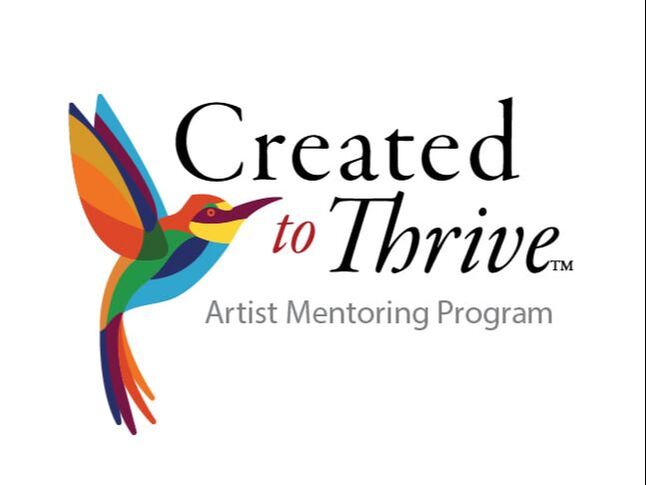
Artist Mentoring Program
A proven pathway for artists who want to grow as an artist from a uniquely Christian perspective while learning to create a consistent income.
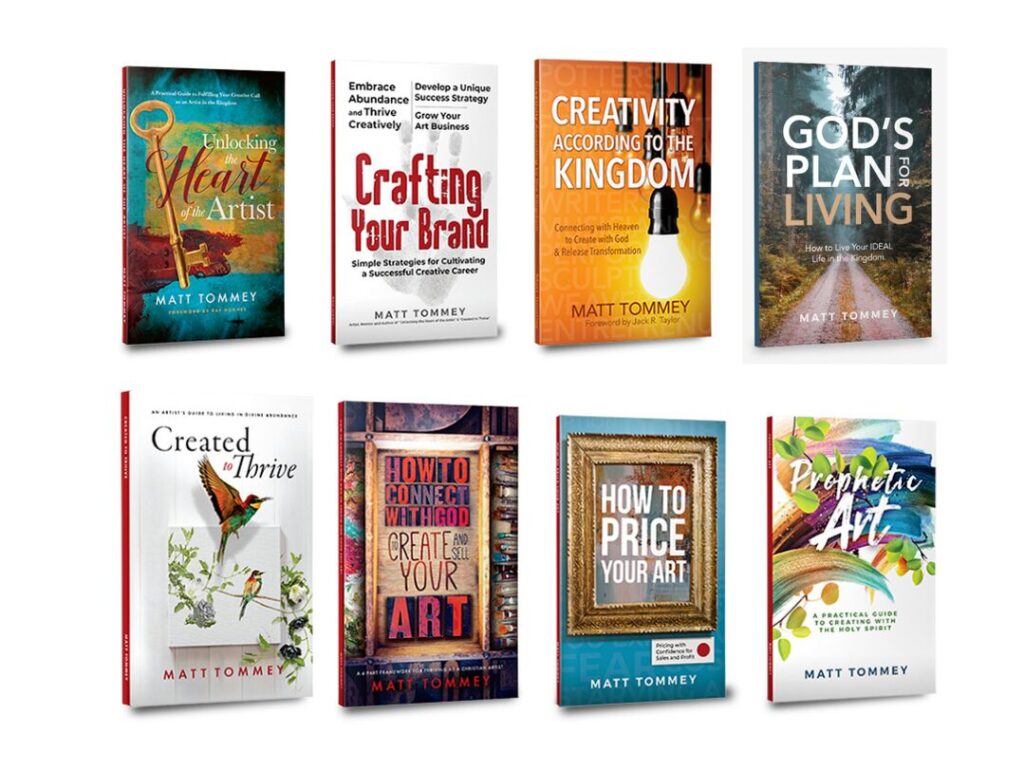
Books for Christian Artists
Read some of Matt’s books to inspire your walk with the Lord as an artist. Topics include prophetic art, business, healing, renewing your mind and the Kingdom.
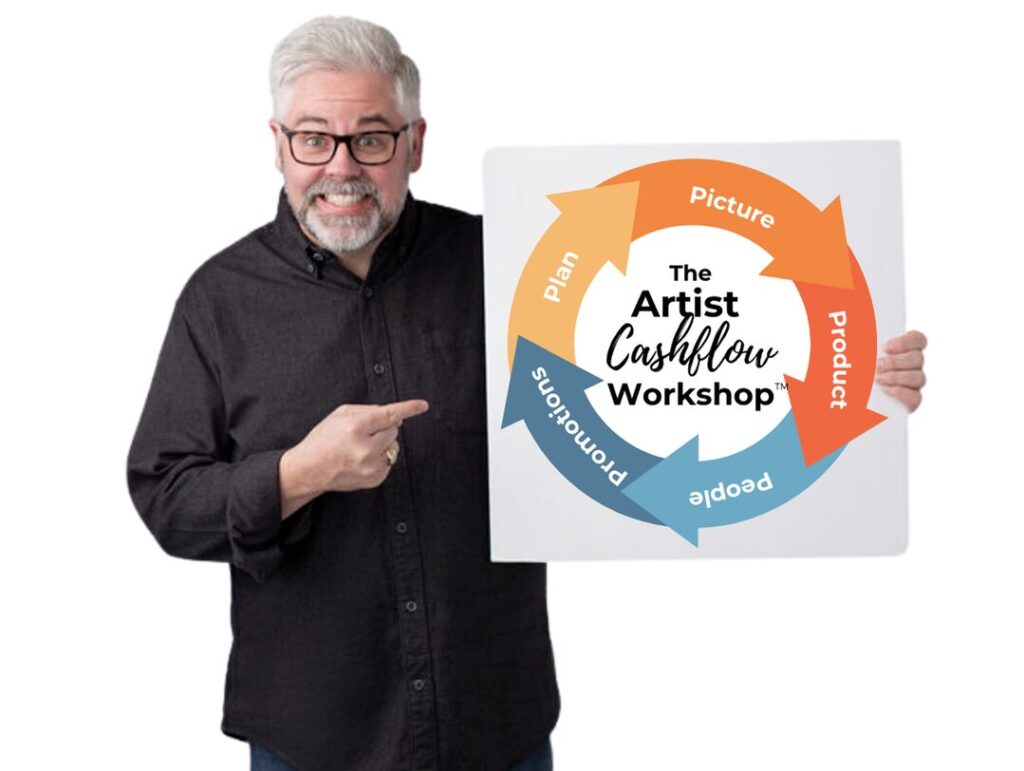
Free Video Training
Watch this free video training to find out all about The Artist Cashflow Wheel and how you can start to create consistent income in your art business.
Exploring the Freelance Frontier: Unlocking the Potential for Artists
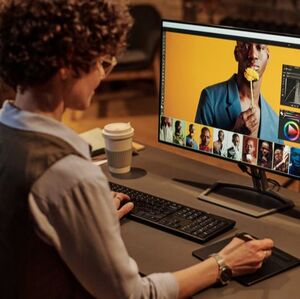
Freelance work has become a thriving avenue for artists to leverage their skills, creativity, and passion while making money. Whether you are a graphic designer, illustrator, or photographer, freelancing offers endless possibilities to showcase your talent, work on diverse projects, and build a sustainable career. In this article, we will delve into the potential of freelance work for artists and provide practical, proven insights to help you get started, market your skills, find clients, and navigate the freelance landscape in a way that aligns with your artistic vision.
- Graphic Design
Transforming Ideas into Visual Solutions: As a graphic designer, you have the power to transform ideas into compelling visual solutions. Start by building a strong portfolio that showcases your diverse skills and demonstrates your unique style. Promote your work through online platforms like Behance, Dribbble, or your personal website. Join design communities and engage in networking events to connect with potential clients. Additionally, consider specializing in niche areas such as logo design, branding, or web design to carve out a distinct market presence. - Illustration
Breathing Life into Stories and Concepts: Illustration allows artists to breathe life into stories, concepts, and ideas. Develop a cohesive and captivating portfolio that showcases your range and versatility. Participate in art competitions, submit work to magazines or online publications, and share your illustrations on social media platforms like Instagram or Pinterest. Collaborate with writers, authors, and content creators to provide visual storytelling solutions. Consider offering services for book covers, editorial illustrations, character design, or concept art to attract a diverse range of clients. - Photography
Capturing Moments and Telling Stories: Photography is a powerful medium for capturing moments, evoking emotions, and telling stories. Build a captivating portfolio that highlights your technical skills, artistic vision, and ability to capture unique perspectives. Create an online presence through a website or platforms like Instagram or 500px to showcase your work. Network with event organizers, businesses, and individuals who may require professional photography services. Offer specialized services like product photography, portrait sessions, event coverage, or stock photography to cater to different client needs. - Marketing Your Skills
Marketing is key to securing freelance projects and attracting clients. Develop a strong online presence by optimizing your website, portfolio, and social media profiles. Clearly communicate your artistic style, strengths, and unique selling points. Utilize targeted keywords and hashtags to enhance discoverability. Network with professionals in related fields, attend industry events, and join online communities to expand your reach. Engage in content marketing by sharing valuable tips, insights, and behind-the-scenes glimpses into your creative process to establish yourself as an authority in your niche. - Finding Clients
Finding clients can be a combination of proactive outreach and building a strong reputation. Leverage online freelance platforms such as Upwork, Freelancer, or Fiverr to connect with clients seeking artistic services. Craft a compelling profile, emphasize your expertise, and showcase your portfolio. Proactively reach out to potential clients, agencies, or businesses that align with your artistic vision. Attend industry-specific events or collaborate with professionals in related fields to expand your network. Ask for referrals from satisfied clients to tap into word-of-mouth marketing. - Navigating the Freelance Landscape
Navigating the freelance landscape requires effective project management and professionalism. Clearly define project scopes, deliverables, and timelines to manage client expectations. Use contracts or agreements to protect your rights, outline payment terms, and establish project boundaries. Develop a pricing structure that reflects your skills, experience, and market value. Create a streamlined workflow, utilize project management tools, and maintain open communication channels with clients to ensure smooth project execution.
Freelance work offers artists a world of possibilities to showcase their talent, pursue their artistic vision, and make money doing what they love. By exploring the potential in graphic design, illustration, or photography, artists can unlock diverse opportunities, attract clients, and build a successful freelance career. Remember to market your skills effectively, find clients through proactive outreach and networking, and navigate the freelance landscape with professionalism. Embrace the freelance frontier, and embark on a rewarding journey of artistic expression, creative fulfillment, and financial success.
Mastering Social Media: A Guide to Selling Your Art Online

Social media platforms have revolutionized the way artists can promote and sell their artwork. Platforms like Facebook, Instagram, TikTok, and YouTube offer a vast and engaged audience, providing artists with incredible opportunities to showcase their creations, connect with potential buyers, and monetize their art. In this article, we will explore practical tips on leveraging these platforms to successfully sell your artwork and maximize your earning potential.
When it comes to selling art, different social media platforms offer unique advantages and cater to specific demographics. Here are some specific reasons why artists might want to consider using each platform:
- Facebook
- Broad Audience: With over 2.8 billion monthly active users, Facebook provides access to a vast and diverse audience, making it an excellent platform to reach a wide range of potential buyers.
- Facebook Groups: Joining and actively participating in art-related groups allows artists to connect with art enthusiasts, showcase their work, and engage in meaningful conversations that can lead to sales.
- Facebook Marketplace: Artists can leverage the built-in marketplace feature to list and sell their artwork directly to local buyers.
- Broad Audience: With over 2.8 billion monthly active users, Facebook provides access to a vast and diverse audience, making it an excellent platform to reach a wide range of potential buyers.
- Instagram
- Visual Focus: Instagram is a visually-driven platform, making it ideal for artists to showcase their artwork through high-quality images and videos.
- Artistic Community: Instagram has a large and engaged art community, including collectors, galleries, and fellow artists, providing ample opportunities for networking, collaboration, and exposure.
- Instagram Shopping: Artists can take advantage of the Instagram Shopping feature to tag their artwork with product information, enabling followers to make purchases directly within the app.
- Visual Focus: Instagram is a visually-driven platform, making it ideal for artists to showcase their artwork through high-quality images and videos.
- TikTok
- Viral Potential: TikTok’s algorithm favors creative and engaging content, allowing artists to showcase their artwork in unique and attention-grabbing ways. A viral TikTok video can quickly reach a massive audience and generate significant interest in an artist’s work.
- Youthful Audience: TikTok has a predominantly young user base, making it an excellent platform for artists who create contemporary or trendy artwork that resonates with younger demographics.
- Authenticity and Personality: TikTok encourages authenticity and behind-the-scenes glimpses into an artist’s process. Artists can create relatable and entertaining content that helps them build a loyal following and attract potential buyers.
- Viral Potential: TikTok’s algorithm favors creative and engaging content, allowing artists to showcase their artwork in unique and attention-grabbing ways. A viral TikTok video can quickly reach a massive audience and generate significant interest in an artist’s work.
- YouTube
- Video Content: YouTube is the go-to platform for video content, allowing artists to create in-depth art tutorials, studio vlogs, or time-lapse videos showcasing their creative process. This platform is ideal for artists who excel at storytelling and want to share their techniques with a broader audience.
- Educational Channel: Artists can establish themselves as experts in their field by sharing their knowledge and insights through educational content. This builds credibility and attracts viewers who may become potential buyers or students.
- Monetization Opportunities: YouTube’s Partner Program allows artists to monetize their channel through advertisements, memberships, and merchandise sales, providing additional income streams.
- Video Content: YouTube is the go-to platform for video content, allowing artists to create in-depth art tutorials, studio vlogs, or time-lapse videos showcasing their creative process. This platform is ideal for artists who excel at storytelling and want to share their techniques with a broader audience.
It’s worth noting that artists can explore other platforms as well, depending on their target audience and artistic style. Platforms like Pinterest, LinkedIn (for professional connections), and even personal websites or blogs can serve as additional avenues for promoting and selling artwork. Understanding the unique advantages and audience demographics of each platform enables artists to tailor their strategies, reach the right audience, and maximize their success in selling their art.
Building an Engaging Social Media Presence
- Choose the Right Platforms: Identify the social media platforms that align with your target audience. Focus your efforts on platforms where your ideal buyers are active and engaged.
- Consistent Branding: Maintain a consistent visual identity across your social media profiles. Use high-quality images of your artwork, create a cohesive aesthetic, and establish a recognizable brand that reflects your unique artistic style.
- Compelling Content: Share captivating content that showcases your artwork, creative process, and the stories behind your pieces. Engage your audience through behind-the-scenes videos, tutorials, and meaningful captions that invite them into your artistic journey.
Growing Your Audience
- Hashtags: Utilize relevant and popular hashtags to expand the reach of your posts. Research industry-specific hashtags, as well as location-based or theme-based tags, to attract a targeted audience.
- Collaboration and Cross-Promotion: Collaborate with other artists, influencers, or brands in complementary niches to widen your exposure. Cross-promote each other’s work, host joint giveaways, or create collaborative projects to reach new audiences.
- Engage with Your Community: Respond to comments, messages, and direct inquiries promptly. Show genuine interest in your followers and engage in conversations to build strong relationships and foster a loyal fan base.
Showcasing and Selling Your Art:
- Visual Storytelling: Use captivating visuals and compelling captions to tell stories about your art. Share the inspiration behind your pieces, the creative process, and the emotions they evoke. Encourage your followers to connect with your art on a deeper level.
- Limited Editions and Exclusivity: Create a sense of exclusivity and scarcity by offering limited edition prints, custom commissions, or exclusive releases to your social media followers. This can create a sense of urgency and drive sales.
- Direct Selling: Use the features provided by social media platforms, such as Instagram’s Shopping feature or Facebook’s Marketplace, to facilitate direct sales. Ensure your pricing and payment processes are clear and user-friendly.
Leveraging Live Videos and Stories
- Live Q&A Sessions: Host live Q&A sessions where you can interact with your audience, answer questions, and provide insights into your artistic process. This helps build trust and rapport with potential buyers.
- Live Art Demonstrations: Stream live art demonstrations, showcasing your skills and techniques. Engage your audience by explaining your creative choices and inviting them to witness the creation of a piece in real-time.
- Stories for Behind-the-Scenes: Use the Stories feature to share behind-the-scenes glimpses into your art studio, upcoming projects, or works in progress. These candid, fleeting moments create a sense of exclusivity and offer a more personal connection with your followers.
Social media platforms have revolutionized the way artists can promote and sell their artwork. By building an engaging social media presence, growing your audience, showcasing your art effectively, and leveraging live videos and stories, you can successfully sell your artwork and connect with art enthusiasts from around the world. Embrace the power of social media to amplify your artistic journey, cultivate a thriving community, and unlock new opportunities for monetizing your creativity. Start today, and let your art shine in the digital realm.
Exploring the Revolutionary World of Digital Currencies and NFT’s for Artists
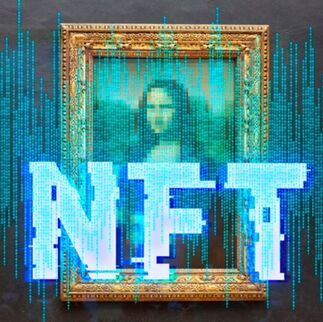
The art world has witnessed a remarkable revolution with the advent of digital currencies and non-fungible tokens (NFTs). These blockchain-based technologies have opened up exciting new avenues for artists to monetize their digital creations, challenge traditional notions of ownership, and connect directly with their audience. In this article, we will dive into the world of NFTs, providing a comprehensive overview of their significance, explaining how to mint and sell them, and discussing the potential benefits and challenges that artists may encounter in this emerging trend.
- Understanding NFTs
Non-fungible tokens (NFTs) are unique digital assets that are recorded on a blockchain, providing proof of authenticity, scarcity, and ownership. Unlike cryptocurrencies such as Bitcoin or Ethereum, which are interchangeable, NFTs represent distinct items, such as digital artworks, collectibles, or virtual real estate. Each NFT carries a unique digital signature, allowing artists to sell and transfer ownership securely. - Minting and Selling NFTs
To mint an NFT, artists need to choose a blockchain platform that supports NFT creation, such as Ethereum or Binance Smart Chain. They can then upload their digital artwork, set parameters like edition size or royalties, and mint the NFT. Once minted, artists can list their NFTs on digital marketplaces like OpenSea, Rarible, or SuperRare. Potential buyers can bid or purchase NFTs using cryptocurrency, with artists typically receiving a percentage of each subsequent sale. - Benefits for Artists
NFTs offer several benefits for artists, including:- Direct Artist-to-Audience Connection: NFTs enable artists to engage directly with their audience without intermediaries, fostering a stronger sense of community and supporting independent creativity.
- Monetizing Digital Art: Digital artists can now monetize their creations, which were previously challenging to sell or protect against unauthorized duplication. NFTs provide a secure way to prove ownership and authenticity, unlocking revenue streams for digital artworks.
- New Revenue Streams: With NFTs, artists can earn not only through initial sales but also through royalties. Artists can program smart contracts to receive a percentage of future sales, allowing for ongoing passive income.
- Expanded Market Reach: The digital nature of NFTs transcends geographical boundaries, allowing artists to connect with a global audience and potentially increase their visibility and sales opportunities.
- Direct Artist-to-Audience Connection: NFTs enable artists to engage directly with their audience without intermediaries, fostering a stronger sense of community and supporting independent creativity.
- Challenges to Consider
While NFTs present exciting opportunities, artists should be aware of potential challenges:- Environmental Concerns: NFTs have received criticism for their energy consumption and carbon footprint. Artists should research blockchain platforms that prioritize sustainability, such as those transitioning to proof-of-stake mechanisms
- Market Volatility and Speculation: The NFT market is still relatively new and can be subject to price fluctuations and speculative behavior. Artists should carefully consider pricing strategies and market trends to ensure a fair valuation of their NFTs.
- Copyright and Intellectual Property Protection
Artists should remain vigilant in protecting their intellectual property rights, as NFTs do not automatically prevent unauthorized use or infringement. Watermarking or utilizing blockchain platforms with additional IP protection features can help mitigate risks.
The world of digital currencies and NFTs has brought about a transformative shift in the art market, empowering artists to monetize their digital creations and engage directly with their audience. By understanding NFTs, minting and selling them strategically, artists can tap into a dynamic ecosystem that offers new revenue streams and expanded market reach. However, artists should also consider the challenges associated with this emerging trend, including environmental concerns, market volatility, and intellectual property protection. Embrace the exciting world of digital currencies and NFTs, and unlock the potential to redefine the art industry, showcase your digital creations, and shape the future of artistic expression.
Why NFT’s Present a Unique Opportunity for Christian Artists
Although NFT’s are a brand-new technology and unfamiliar to many artists, they present a potentially incredible opportunity for artists who are Christians. Here’s why:
- Spreading Faith and Inspiration
Art has long been a powerful medium for conveying messages of faith, hope, and inspiration. NFTs provide a digital platform for Christian artists to create and share artwork that reflects their beliefs, shares biblical messages, and spreads positivity. By leveraging the accessibility and global reach of NFTs, artists can touch the lives of people around the world with their faith-inspired creations. - Connecting with a Global Audience
NFTs transcend geographical boundaries, allowing artists to connect with a global audience that may otherwise be difficult to reach. Through the internet and digital marketplaces, Christian artists can share their NFTs with individuals from diverse cultures and backgrounds, fostering dialogue and understanding. This presents an opportunity to promote Christian values, share stories of faith, and engage in meaningful conversations with a wide range of individuals. - Supporting Charitable Causes
NFTs can be used as a tool for supporting charitable causes and making a positive impact in the world. Artists can allocate a portion of the proceeds from NFT sales to support initiatives that align with their Christian values, such as humanitarian efforts, poverty alleviation, or community development projects. This allows artists to combine their artistic talents with a spirit of generosity and compassion, making a tangible difference in the lives of others. - Promoting Stewardship of Creation
As Christians, the belief in stewardship and caring for God’s creation is fundamental. NFTs offer a digital alternative to traditional art mediums, reducing the need for physical resources and minimizing the environmental impact associated with art production and distribution. By embracing NFTs, artists can contribute to sustainable art practices and advocate for responsible stewardship of the environment. - Inspiring Reflection and Spiritual Growth
NFTs can serve as a catalyst for reflection and spiritual growth. Christian artists can create artworks that provoke thought, prompt introspection, and encourage viewers to explore their faith. Through the unique attributes of NFTs, such as interactive elements or audiovisual components, artists can provide immersive and transformative experiences that engage viewers on a deeper level.
- Engaging with Digital Natives
NFTs primarily resonate with the digital native generation, who are deeply immersed in the digital realm. By embracing this new medium, Christian artists can connect with younger audiences and engage them in discussions surrounding faith and spirituality. Through thought-provoking and visually captivating NFTs, artists have the opportunity to foster dialogue, address questions, and provide guidance to individuals seeking spiritual fulfillment in a digital age.
NFTs offer Christian artists an exciting and unprecedented opportunity to make a positive impact in the world. By leveraging this new digital medium, artists can share their faith, connect with a global audience, support charitable causes, promote stewardship, inspire reflection, and engage with digital natives. Embracing NFTs allows Christian artists to use their talents and creativity to create meaningful, faith-inspired artwork that resonates with individuals around the world, fostering a deeper understanding of Christian values and contributing to the positive transformation of society.
NOTE: The author generated this text in part with GPT-3, OpenAI’s large-scale language-generation model. Upon generating draft language, the author reviewed, edited, and revised the language to their own liking and takes ultimate responsibility for the content of this publication. This information is to be used at your own risk and in conjunction with good business practices and professional help as needed.
